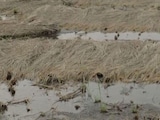There are fewer than 7,000 cheetahs left around the world
Eight cheetahs from Namibia have arrived in their new home, Madhya Pradesh's Kuno National Park, where they were released by Prime Minister Narendra Modi as part of the programme to reintroduce the feline in India.
Here are the top points in this big story:
- Prime Minister Narendra Modi today released three cheetahs into the Kuno National Park. Sporting a fedora hat, the PM was also seen photographing the felines with a professional camera. He released two cheetahs from enclosure number one and after that, about 70 meters away, from the second enclosure released another one.
- Radio collars have been strapped on all the cheetahs to be monitored through satellite. There is a dedicated monitoring team behind each cheetah which will monitor their movements around the clock.
- The plane with cheetahs arrived at Gwalior's Maharajpura airbase, operated by the Indian Air Force (IAF), shortly before 8 am. Civil Aviation Minister Jyotiraditya Scindia oversaw the arrangement as the cheetahs were transported to the air force chopper which flew them to Kuno National Park.
- "The cheetahs have arrived in their new home- KUNO - heavenly habitat for our cats," the minister tweeted, sharing pictures from the airbase. Prime Minister Narendra Modi, who is celebrating his birthday today, will release the wild cats in quarantine enclosures of the park.
- No greater gift for Madhya Pradesh than this on Prime Minister Narendra Modi's birthday, state Chief Minister Shivraj Singh Chouhan said this morning, calling the 'historic' ferrying of the wild cats from Namibia to the Kuno National Park the biggest wildlife incident of the century. This will rapidly boost tourism in the state, especially in the Kuno-Palpur region, he said.
- "The cats are under very mild sedation, but they are not tranquilised. They are all looking great," said Dr Laurie Marker, world's leading expert on cheetahs, who was on the jet with the big cats, said.
- According to the Cheetah Conservation Fund (CCF), an international not-for-profit organisation headquartered in Namibia and dedicated to saving the fastest land animal, the five female cheetahs are aged between two and five years, while the males are aged between 4.5 years and 5.5 years.
- India in the past was home to Asiatic cheetahs, but the species was declared extinct domestically by 1952. The big cats are being brought to India from Namibia as part of an intercontinental translocation project.
- The national park is located in Madhya Pradesh's Sheopur district, located around 165 km from Gwalior. The Kuno park was selected as a home because of its abundant prey and grasslands. But critics have warned that the cheetahs may struggle to adapt to the habitat and may clash with the significant number of leopards already present.
- The 'African Cheetah Introduction Project in India' was conceived in 2009 and a plan to introduce the big cat by November last year in KNP was delayed due to the COVID-19 pandemic, officials have said. Considered vulnerable under the IUCN Red List of Threatened Species, there are fewer than 7,000 cheetahs left around the world -- primarily in the African savannas.
Advertisement
Advertisement
Advertisement















